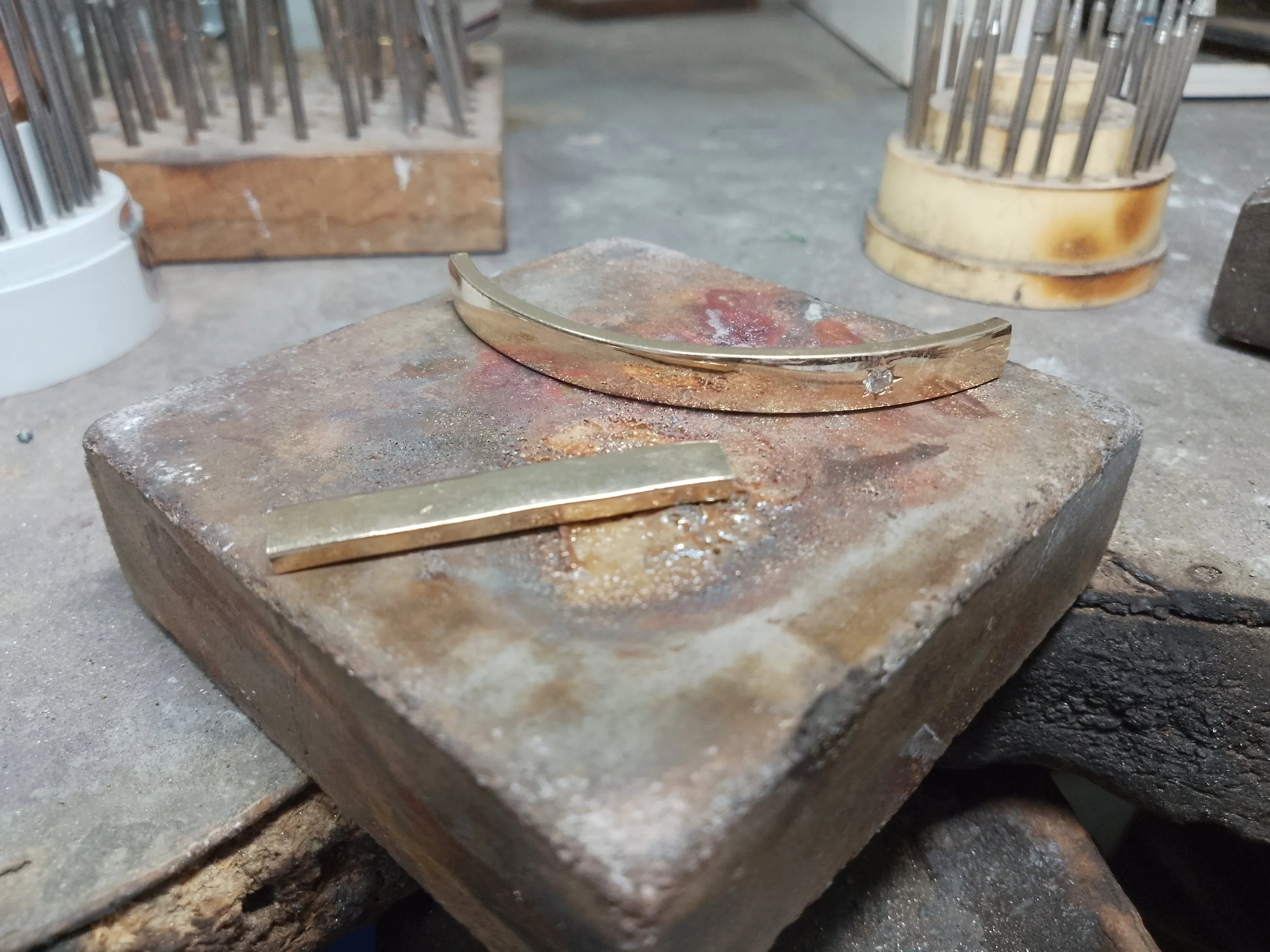Recycling gold without a hallmark
16th November 2025 - Customer Location: Devon Hills, Tasmania
The bangle and gemstone to be recycled.
I was recently asked to make some jewellery out of a bangle that was not hallmarked. Hallmarks at the basic level identify the precious metal the piece is made of. They can also indicate the manufacturer, date and country it was made.
With rings, hallmarks are often removed during resizing and other work. With a bangle it was a bit more unusual. The customer said that they had a valuation stating that the gold was 14ct. From the mixture of gems set into it I assume the bangle was made from recycled jewellery at some stage. We proceeded to design the new piece of jewellery to be made knowing we had more than enough gold and would come back to the caratage later.
9ct and 18ct acid testing bottles….I have had these a very long time.
Once I started working with the gold I became sceptical about it being 14ct due to the colour and feel. I acid tested the gold for both 9ct and 18ct but I do not have 14ct acid. It passed the 9ct test but failed the 18ct …..as I expected. I was still uncertain this gold was 14ct.
A small rectangular section of the bangle weighing 5.69 grams.
I turned to another method to get an indication of purity. I cut off a section of the bangle, flattened it out to a rectangle and measured it up.
Recreating the measurements of the piece of bangle on the computer.
From there I recreated the dimensions of the piece of the bangle on the computer and got a volume for the geometry. According to the purity of the gold alloy the weight of that volume will vary. For example 9ct gold contains 37.5% pure gold and 18ct is double that at 75%. Pure gold being extremely dense the more pure gold used the heavier the same item.
9ct should come in at a weight of about 5.44 grams and 14ct gold about 6.42 grams. This piece weighed 5.69 grams. With that weight it was highly unlikely it was 14ct gold and may possibly be 10ct gold. I do not have 10ct acid testing solution however.
So why do you not have acid testing for 10 and 14ct gold?
A 9ct metal stamp used to create a hallmark.
I have very little need to acid test jewellery in general and both 10ct and 14ct gold alloys are predominantly used in North America.
We started seeing more 10ct and 14ct jewellery here in Australia after one of Australia’s largest jewellery chains opened stores in the American market. I am guessing the introduction of more 10ct and 14ct jewellery was done due more to streamlining manufacturing than for the good of the Australian jewellery industry.
The finished ring and what to stamp it with?
The piece created form the old jewellery, a slightly rose colour alloy.
This is the second of 3 pieces that I am making for this customer in Tasmania from old jewellery. The plan is for one to go to each of her three daughters when the time comes. Until then she can wear and enjoy them herself.
The diamonds and sapphire were also recycled. The Ceylon Type colour sapphire is stunning despite having a few scratches and chips on it.
Article: Sapphires and not unbreakable - Going, going, gone.
The diamonds are a mixture of old single cut diamonds of average quality (or less) but they were used for sentimental reasons. They were also a bit over the shop in size but we made it work.
I spoke to the customer and advised her that I was unwilling to hallmark the gold 14ct as her valuation stated it was. I gave her the option of either having the new piece without a hallmark or hallmarked 9ct gold purity it was passing the acid test at.
Another option was to send a section of the gold off to be assayed to get a definitive purity but the cost would have been prohibitive. She decided to hallmark the piece 9ct.
Now onto the third piece using more of the gold from the bangle.




